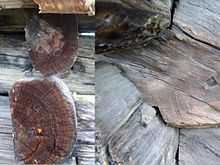Log boom


A log boom is a barrier placed in a river, designed to collect and or contain floating logs timbered from nearby forests sometimes called a fence or bag. The term is also used as a place where logs were collected into booms, as at the mouth of a river. With several firms driving on the same stream, it was necessary to direct the logs to their owner's respective booms, with each log identified by its own patented Timber Mark. One of the most well known logbooms was in Williamsport, Pennsylvania, along the Susquehanna River. The development and completion of that specific log boom in 1851 made Williamsport the "Lumber Capital of the World".[1]
As the logs proceeded downstream, they encountered these booms in a manner that allowed log drivers to control their progress, eventually guiding them to the river mouth or sawmills. Most importantly, the booms could be towed across lakes, like rafts, or anchored while individual logs awaited their turn to go through the mill. Booms prevented the escape into open waters of these valuable assets.
Log boom foundations were commonly constructed of piles or large stones placed into cribs in a river to form small islands. The booms were themselves large floating logs linked together end to end, like a large floating chain connecting the foundations while strategically guiding the transported logs along their path.
Log booms were used in the United States and Canada, during the 19th and early 20th centuries.
See also
External links
References
- ↑ "The Susquehanna Log Boom, Williamsport, PA, 1890". ExplorePAHistory.com. 2011. Retrieved July 21, 2014.